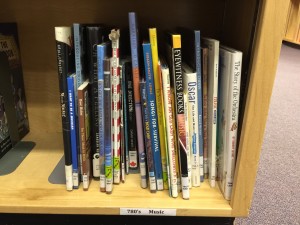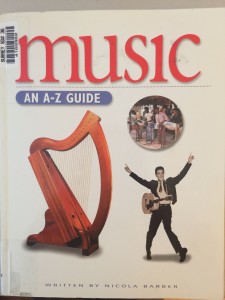”One of the most important tasks of a school librarian is to help students and teachers find the best materials available – in all formats – to support teaching and learning.” (Riedling, Shake & Houston, p. 18)
In order to perform the task, it is necessary for a teacher-librarian to acquire knowledge on what is being taught and learned in the school community. For myself being a core music teacher, there is no doubt that I would be interested in the music, non-fiction section of the library. In furtherance of evaluating the current library collection of resources for music, an understanding of the music program at the school is crucial.
Curricular Connection
I have been teaching kindergarten to grade seven music at Royal Heights Elementary, Surrey, for almost 10 years. Since I know the students and the community quite well, and the administrator is supportive in the music program, I decided to develop a new program based on classical music and new B.C. curriculum.
According to the B.C. arts education curriculum (both the new one and the previous one), students are expected to learn about music from a variety of tradition, culture, and community. Personally, I believe that through the study of music in different periods in the music history, students would be able to make connection to how music style has evolved into what we have nowadays.
This year is the “trial and error” year, and so far, the students responses are positive. Students show excitement and curiosity in learning about the lives of the composers, such as J.S. Bach, Mozart, Vivaldi, etc. They are also enthusiastic about learning musical elements through singing and playing instrument accompaniments to the compositions of the composers we studied. I do mostly direct teaching with the primary classes. On the other hand, I take the approach of inquiry-based learning, in which I work alongside and learn collaboratively with my intermediate students. Hence, for this assignment, I would evaluate the library resources with the intermediate students as my targeted users of the resources.
Rubric for Evaluating Resources
After reading Asselin, Branch & Oberg’s Achieving Information Literacy: Standards for School Library Program in Canada, and Riedling, Shake & Houston’s Reference Skills for the School Librarian: Tools and Tips, I designed the following rubric to help evaluating the reference resources.
|
Non-satisfactory |
Acceptable |
Exemplary |
|
|
Relevancy (Curricular Support) |
Material supports a small part of the curriculum |
Material supports much of the curriculum |
Material fully supports the curriculum |
|
Currency |
Copyright date exceeds 10 years |
Copyright date is within the last 10 years |
Copyright date is within one year |
|
Accuracy of Information |
Contains incorrect or biased information |
Contains accurate information, but omits facts regarding unfavourable |
Contains accurate, unbiased information |
|
Ease of Use |
Information is poorly organized |
Information is organized without an index |
Information is well organized with an index |
|
Efficient Use of Library Space |
Resource uses unreasonable amount of space, i.e.. does not fit into regular shelf |
Resource uses decent amount of library space |
Resource does not need much of a space |
|
Cost |
Cost is exceeded the school budget |
Cost is within the school budget |
Cost is minimal or free of cost |
|
Future Updates |
No future updates are available |
Resource contains facts, no updates needed |
Future updates are available with minimum or no cost |
Evaluation of a Current Library Resource
Photo: Music (non-fiction) section in Royal Heights Elementary Library
The Royal Heights Elementary library has a small collection of resources for music. There are less than 30 reference resources and approximately 15 story books relate to music matters. Among the reference resources, there are about 7 biography books that I often use to introduce composers of our studies. For this assignment, I have chosen a “music dictionary” which includes information regarding composers, different styles of music, and different kinds of instrument from a variety of cultures.
Book: Barber, Nicola. Music: An A-Z Guide. New York: Watts Reference, 2001.
Photo: Cover page of the book
Using the above mentioned rubric, the following is my evaluation of the resource:
Relevancy: The book contains relevant, truthful, and unbiased informations on
musicians, musical instruments and styles. However, informations are brief and introductory.
[Acceptable]
Currency: The publication date of the book is 2001, more than 10 years.
[Not satisfactory]
Accuracy of Information: The book contains accurate, and brief information, detailed facts are omitted.
[Acceptable]
Ease of Use: The information is organized with an index at the back of the book.
[Exemplary]
Efficient Use of Space: The book is in decent size, and it fits into the bookshelf.
[Acceptable]
Cost: The book costs Canadian dollars $27.95. The price is reasonable.
[Acceptable]
Future Updates: The book is 14 years old, and no updates is available for the past 14 years. However, the book contains mostly facts that updates are not necessary.
[Acceptable]
On average, the resource is considered “acceptable” as a reference resource. It deserves a place on the bookshelf on the Royal Heights Elementary library, and will not be considered for weeding.
Evaluation of a Potential Resource
Resource accessibility is my major concern of any potential resources. In the new music program I am designing, I try to facilitate individual inquiry project in which individual student would decide on the musician that he or she would like to study. In the past, my students and I had experienced situations when more than one student were studying the same composer, but there was only one reference resource available in the library. In our recent inquiry project on the role of music/sound in movies, researching online is our only option as there was no printed resources available in our school library. Therefore, I search for an online database as a potential resource.
Website: Classics for Kids
Relevancy: The website contains information on composers, musical instruments, musical theory, as well as musical careers. The informations are brief and introductory, and may not be detailed enough to fully supports the curriculum.
[Acceptable]
Currency: The website is maintained and information is updated consistently. The last update was in 2016.
[Exemplary]
Accuracy of Information: I have not read through all the information. However, for the 6 composer biographies that I have read, all informations are accurate. As the information is brief, some facts are omitted.
[Acceptable]
Ease of Use: The website is well organized with tabs at the top. I think it is user- friendly, and I do not think that intermediate students would have much trouble searching for desired information using this website. Moreover, there is a “search” engine embedded in the site, information could easily be located using keyword search.
[Exemplary]
Efficient Use of Space: No storage space is needed.
[Exemplary]
Cost: The website is free of charge.
[Exemplary]
Future Updates: As mentioned above, the website is updated regularly.
[Exemplary]
The only disadvantage of this website is that it is not advertisement free. The site is funded by the advertisement ads on the website pages, therefore, it is free of charge. Even with the advertisements here and there on different pages, I think this online is rated between acceptable to exemplary, and should be included in our library’s digital resource list.
References
Area of Learning: Arts Education. BC’s New Curriculum: Building Student Success. Web. February 6th, 2016. Retrieved from https://curriculum.gov.bc.ca/sites/curriculum.gov.bc.ca/files/pdf/ae_learning_standards.pdf
Asselin, M., Branch, J., & Oberg, D., (Eds). Achieving information literacy: Standards for school library programs in Canada. Ottawa, ON: Canadian School Library Association & The Association for Teacher-Librarianship in Canada.
Barber, Nicola. Music: An A-Z Guide. New York: Watts Reference, 2001. Print.
Riedling, Ann Marlow, Loretta Shake, and Cynthia Houston. Reference Skills for the School Librarian: Tools and Tips. Third ed. Linworth, 2013. Print. An Imprint of ABC-CLIO, LLC
School District No. 36 (Surrey) Teacher-Librarian Handbook. Surrey School District, 2007. Print.


